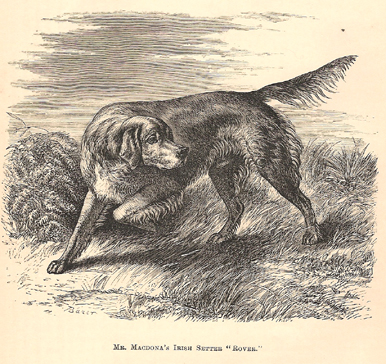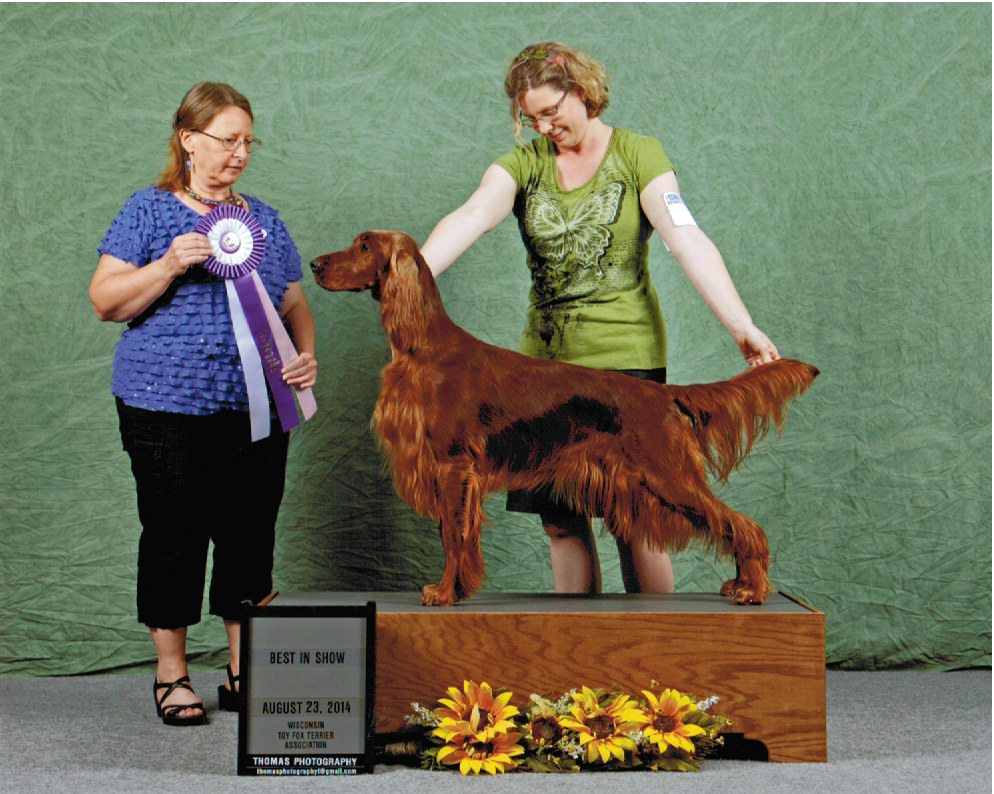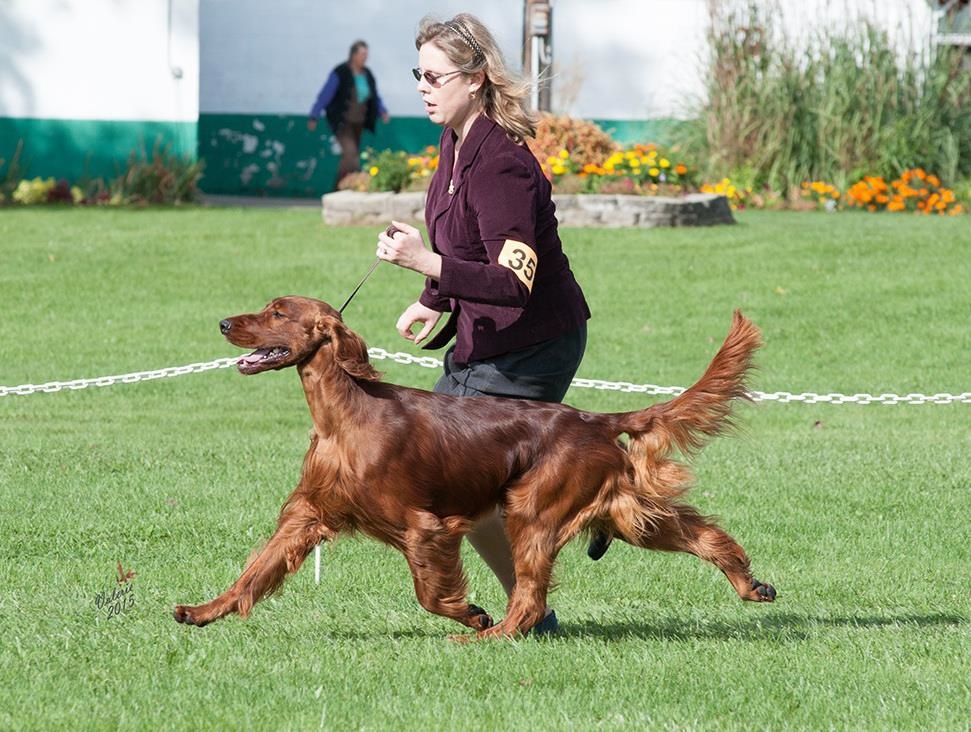All the wonderful attributes of Irish Setters are the result of hundreds of years of selection by breeders who have balanced four critical elements—physical structure, temperament, health, and breed type–to create the breed we know today.
Origins of the breed
Irish Setters are one of four distinct setter breeds, and were bred for locating (by “setting” upland game birds. The first written reference of a Setter appears in 1570. By the early 18th century, setters–probably derived from spaniel, pointer, and possibly a hound breed–had been bred for a distinct purpose, and Ireland had its own variety.
Setters located birds and then went down into a crouch or “set.” Upland birds were often located on rolling terrain with thick vegetation, and hunters caught birds by throwing a net over the bush. A hunter needed a close partnership with his dog, and setters worked within walking distance (15 feet) of their human companions. When hunters began using guns, setters kept their job of locating birds.
While many Irish Setter owners of today choose to not hunt with their dogs, most Irish Setters retain strong hunting instincts and working ability. Irish setters continue to this day to be working gundogs.

Important building blocks of a quality dog
Physical structure
Physical structure directly affects whether a dog can perform the function for which it was bred—in this case upland bird hunting. A well-built dog moves effortlessly and has endurance; this cannot happen without sound underlying structure. Principles of engineering and physics apply just as much to building a sound dog as they do to building any man-made structure. The length of bones, the angles at which they fit together, how they interact with muscles and ligaments all determine overall balance and efficiency of gait, whether a dog may be prone to certain injuries, and overall stamina.

Temperament
A sound mind is as important as a sound body for a successful working dog. Whether in the field, performance event, show ring, or the backyard a dog’s mental characteristics directly impact the job a dog does, how well he does it, and his willingness to work with his human companion. Irish Setters are described as energetic, friendly, intelligent, rollicking, outgoing, and stable. These characteristics are important to the breed’s original purpose of a close working personal hunting dog; they indicate a breed that likes people.

Breed Type
Breed type refers to the entire package of characteristics and traits that make the Irish Setter distinct and recognizable from any other breed. If you saw a silhouette of a dog standing or moving at a distance and immediately knew what breed it was, that is a dog with breed type. Many characteristics contribute to breed type: red hair, soft expression, head and tail carriage, topline, length of neck, body proportion, movement, temperament. The Standard for the breed discusses all the features that make the Irish Setter distinct from other breeds.
Health
Health is directly related to longevity of performance and the ability to fulfill the function for which the breed was bred. A personal hunting dog may possess instinct, aptitude, trainability, and good structure, but if he is not healthy he will not work in the field for long. The time invested to breed and train a good working dog is wasted if a dog cannot walk, see, etc. Good breeders and hunters take the health of their dogs very seriously; they want their companions to have long careers with them.
Irish Setter Breed Standard
The breed standard is a written description that describes the physical structure (length and angles of bones, body proportion etc.), temperament, and breed type (features that make the breed distinct from other breeds). It is a blueprint of agreed upon traits breeders are trying to achieve and make predictable across generations, and the measuring stick of quality. A breeder’s aim is to build dogs that match the ideal described in the standard.
Every breed is the result of careful selection of specific traits over many generations. The attributes that attract you to the Irish Setter—their natural instinct for birds, personalities, or the way they look—is the product of hundreds of years of careful breeding that has made all of the features described in the standard predictable from generation to generation.
If the dog described in the standard does not match what you are looking for there may be another breed that is a better fit. We’ve pulled a selection of language from both the AKC and UKC standards that gives good insight to the essence of the breed.
General appearance
“The Irish Setter is an active, aristocratic bird dog, rich red in color, substantial yet elegant in build… Afield, the Irish Setter is a swiftmoving hunter; at home, a sweet natured, trainable companion. At their best, the lines of the Irish Setter so satisfy in overall balance that artists have termed it the most beautiful of all dogs. The correct specimen always exhibits balance, whether standing or in motion. Each part of the dog flows and fits smoothly into its neighboring parts without calling attention to itself.” (AKC standard)
“An upstanding, active dog of mahogany or rich chestnut color, substantial yet elegant, and always exhibiting balance whether standing or moving.” (UKC standard)

Movement
“At the trot the gait is big, very lively, graceful and efficient. At an extended trot the head reaches slightly forward, keeping the dog in balance. The forelegs reach well ahead as if to pull in the ground without giving the appearance of a hackney gait. The hindquarters drive smoothly and with great power.” (AKC standard)
“At a trot the gait is big, lively, efficient and graceful, with a high head. The hindquarters drive smoothly with great power. The forelegs reach well ahead as if to pull the ground.“ (UKC standard)

Character
“The Irish Setter has a rollicking personality. Shyness, hostility or timidity are uncharacteristic of the breed. An outgoing, stable temperament is the essence of the Irish Setter. “ (AKC standard)
“An energetic dog, friendly and intelligent. The breed’s rollicking personality is a defining characteristic.” (UKC standard)

Breed Health
Overall, Irish Setters are a healthy breed. The Irish Setter Club of America recommends three health tests for Irish Setters, Hip dysplasia, thryroid (looking specifically for autoimmune antibodies), and PRA (Progressive Retinal Atrophy). We also do CERF testing (eyes) on our dogs.
All health test results on our breeding stock–as well as other relations, we often test multiples in a litter–are recorded on the Orthopedic Foundation for Animals (OFA) website at www.ofa.org.On the OFA site, type in the kennel name Anamacara in the search box, and click Go to access health test records for our individual dogs.
OFA is the online database for health test results for all breeds; there are additional tests for problems that are a concern to some breeds, but are not typical problems in Irish Setters. OFA also manages the Canine Health Information Center (CHIC) database. A dog achieves CHIC Certification if it has been screened for every disease recommended by the parent club for that breed and those results are publicly available on the OFA database.